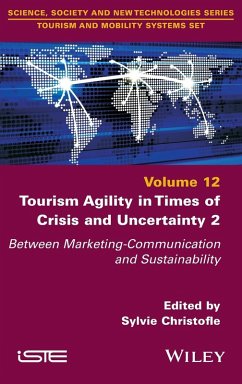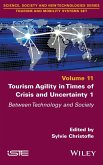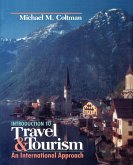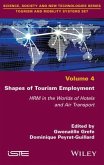ChristofleBetween Marketing-Communication and Sustainability
Tourism Agility in Times of Crisis and Uncertainty 2
Between Marketing-Communication and Sustainability
Herausgeber: Christofle, Sylvie
ChristofleBetween Marketing-Communication and Sustainability
Tourism Agility in Times of Crisis and Uncertainty 2
Between Marketing-Communication and Sustainability
Herausgeber: Christofle, Sylvie
- Gebundenes Buch
- Merkliste
- Auf die Merkliste
- Bewerten Bewerten
- Teilen
- Produkt teilen
- Produkterinnerung
- Produkterinnerung
In times of crisis and uncertainty, tourism suffers multiple transformations such as societal, ecological, technological, and political changes, among many others. Beyond the cyclical adjustments, these upheavals call for agility on the part of tourism territories and organizations at various levels. Tourism Agility in Times of Crisis and Uncertainty 2 explores, from a multidisciplinary perspective, tourism agility through the dimensions of attractiveness, marketing and sustainability. It begins by analyzing the agile attitude of the tourist as a consumer and deciphers a wide range of agile…mehr
Andere Kunden interessierten sich auch für
![Tourism Agility in Times of Crisis and Uncertainty 1 Tourism Agility in Times of Crisis and Uncertainty 1]() ChristofleTourism Agility in Times of Crisis and Uncertainty 1146,99 €
ChristofleTourism Agility in Times of Crisis and Uncertainty 1146,99 €![Tourism Development Tourism Development]() William C GartnerTourism Development111,99 €
William C GartnerTourism Development111,99 €![Tourism Planning Tourism Planning]() Edward InskeepTourism Planning166,99 €
Edward InskeepTourism Planning166,99 €![Introduction to Travel and Tourism Introduction to Travel and Tourism]() Michael M ColtmanIntroduction to Travel and Tourism126,99 €
Michael M ColtmanIntroduction to Travel and Tourism126,99 €![Shapes of Tourism Employment Shapes of Tourism Employment]() G GrefeShapes of Tourism Employment158,99 €
G GrefeShapes of Tourism Employment158,99 €![Marketing Tourism Destinations Marketing Tourism Destinations]() Ernie HeathMarketing Tourism Destinations77,99 €
Ernie HeathMarketing Tourism Destinations77,99 €![Travel, Tourism, and Hospitality Research Travel, Tourism, and Hospitality Research]() JRB RitchieTravel, Tourism, and Hospitality Research127,99 €
JRB RitchieTravel, Tourism, and Hospitality Research127,99 €-
-
-
In times of crisis and uncertainty, tourism suffers multiple transformations such as societal, ecological, technological, and political changes, among many others. Beyond the cyclical adjustments, these upheavals call for agility on the part of tourism territories and organizations at various levels. Tourism Agility in Times of Crisis and Uncertainty 2 explores, from a multidisciplinary perspective, tourism agility through the dimensions of attractiveness, marketing and sustainability. It begins by analyzing the agile attitude of the tourist as a consumer and deciphers a wide range of agile strategies and policies implemented by actors and territories: digital communication by Côte d'Azur destination management organizations, creativity in the French spa sector, integration of attractions and key locations in the Chaîne des Puys and tourism enhancement in Hauts-de-France. The book then analyzes sustainability as a central issue in tourism agility, whether we are talking about flexibly managing visitor flows to major natural heritage sites, characterizing local tourism, thinking about hypermobility or examining soft mobility.
Produktdetails
- Produktdetails
- Verlag: Wiley
- Seitenzahl: 256
- Erscheinungstermin: 26. Juni 2025
- Englisch
- Abmessung: 234mm x 156mm x 16mm
- Gewicht: 540g
- ISBN-13: 9781786309952
- ISBN-10: 1786309955
- Artikelnr.: 74320514
- Herstellerkennzeichnung
- Libri GmbH
- Europaallee 1
- 36244 Bad Hersfeld
- gpsr@libri.de
- Verlag: Wiley
- Seitenzahl: 256
- Erscheinungstermin: 26. Juni 2025
- Englisch
- Abmessung: 234mm x 156mm x 16mm
- Gewicht: 540g
- ISBN-13: 9781786309952
- ISBN-10: 1786309955
- Artikelnr.: 74320514
- Herstellerkennzeichnung
- Libri GmbH
- Europaallee 1
- 36244 Bad Hersfeld
- gpsr@libri.de
Sylvie Christofle is Senior Lecturer in Geography at the Université Côte d'Azur and Deputy Scientific Director of the Institut du tourisme Côte d'Azur, France. Her work focuses on event tourism, MICE (Meeting Incentive Convention Event), territorial marketing, regenerative tourism and smart tourism territories.
Foreword. Thinking on Tourist Destinations as Complex
Systems in Times of Uncertainty xi
Salvador Anton CLAVÉ
Acknowledgments xxvii
Introduction to the Authors of the Two Volumes xxix
Introduction xli
Sylvie CHRISTOFLE based on contributions by Franck DEBOS, David HURON,
Jean-Christophe GAY, Bernard MASSIERA, Otto REGALADO-PEZÚA
and Jacques SPINDLER
Part 1. Marketing and Communication at the Heart of Tourism Agility:
Stories from Actors and Regions 1
Chapter 1. Tourist Consumer-driven Agility: A Framework for Tourism
Marketing 3
Marios SOTIRIADIS and Shiwei SHEN
1.1. Introduction: marketing environment and consumer behavior in the
digital era 3
1.2. Theoretical framework: agile marketing 5
1.3. A blended approach: a framework based on two models 7
1.3.1. Consumer/customer journey in the digital era 7
1.3.2. Marketing implementation: the marketing mix 9
1.4. Proposed framework for implementing marketing agility in tourism 11
1.5. Conclusion 13
1.6. References 14
Chapter 2. Online Communication Agility for International Tourist
Destinations: Cannes, Nice, Monaco 17
Sylvie CHRISTOFLE and Carine FOURNIER
2.1. Theoretical framework 18
2.2. Methodology 20
2.3. Results and discussion 22
2.3.1. Are DMOs early adopters? 22
2.3.2. What publications? 24
2.3.3. What mutual recognition? Measuring interaction 26
2.3.4. Producing a composite index measuring online communication agility
32
2.4. Conclusion 35
2.5. References 36
Chapter 3. "Les Accros du peignoir" (Massif Central): Proof of the Agility
of the French Spa Scene 39
Marie-Ève FÉRÉROL
3.1. Introduction 39
3.2. Methodology 42
3.3. Contextualization: the decline of the Massif Central's flagship
resorts 44
3.4. The remedy for the crisis: a territorial brand based on humor,
inclusivity, experience and openness to the cultural world 46
3.4.1. A reflective work on the identity to be given to the Massif
Central's water towns 46
3.4.2. Choosing humor and self-mockery 47
3.4.3. More punchy, inclusive and experiential communication 49
3.4.4. Water cities: creative and innovative 52
3.5. Conclusion 56
3.6. References 58
Chapter 4. Attractions and Interconnected Destinations: The Case of the
Chaîne des Puys-Limagne Fault UNESCO Site 61
Jean-Bernard MARSAT and Étienne POLGE
4.1. Issues, references and models 62
4.1.1. Spatial features of the local system 63
4.1.2. Management issues: stakeholder profiles, objects and scales of
intervention 66
4.2. Case study 67
4.2.1. Study on the visitors 68
4.2.2. The study of the management of the tourism system affected by
attraction (the CPFL) 72
4.3. Discussion - conclusion 74
4.4. References 75
Chapter 5. Collective Agility at the Heart of Tourism Development in
Hauts-de-France During the Covid Period 79
Sandrine FOURNIER
5.1. Promoting the "HDF destination" in the region 80
5.2. The agility of tourism players: adapt, develop and innovate 81
5.3. Adding value and agility through digitalization 82
5.4. Promotional synergy between official operators/tourism professionals
and citizens/tourists 84
5.5. Methodology, results and discussion 85
5.5.1. Methodology 85
5.5.2. The agility of professional players in HDF 86
5.5.3. The adaptability of official operators/tourism professionals and
citizens/tourists 87
5.5.4. Agility of regional, departmental and local tourism organizations 88
5.5.5. Interrelations between official operators/tour operators and
citizens/tourists 90
5.5.6. Discussion 92
5.6. Conclusion 93
5.7. References 93
Part 2. Sustainability: A Challenge for Tourism Agility? 97
Chapter 6. Managing Visitor Numbers: A Public Policy Challenge for
Preserving and Enhancing our Natural Heritage 99
Émeline HATT and Sylvie CLARIMONT
6.1. Visits to natural areas with a high profile and major management
challenges 101
6.1.1. Large natural sites with high visitor numbers 101
6.1.2. (Over)visiting and visitor management issues 104
6.2. Managers of natural areas increasingly inclined to implement visitor
management systems 105
6.2.1. A variety of visitor management systems in natural areas 105
6.2.2. Experiments to limit visitor numbers in France 108
6.2.3. Regulatory changes to support visitor number management 110
6.3. Visitor management systems: between concrete implementation
difficulties and ambivalent social perceptions 110
6.3.1. Challenges to the creation of operational management territories 110
6.3.2. A principle of regulation accepted, but regulatory measures
criticized by users 112
6.4. Conclusion 115
6.5. References 116
Chapter 7. Metropolitan Areas and Local Tourism 121
Fabrice DECOUPIGNY
7.1. Introduction 121
7.2. Metropolises and local leisure activities 121
7.3. Impact of second homes on attractiveness 126
7.4. Prospective simulations of attractiveness 128
7.5. Conclusion 131
7.6. References 132
Chapter 8. Hypermobility and Environmental and Societal Challenges 133
Isabelle FROCHOT, Véronique MONDOU and Philippe VIOLIER
8.1. Introduction 133
8.2. Methodology 133
8.3. Analytical framework 134
8.4. Main results 136
8.4.1. Varied combinations 136
8.4.2. Effects of the pandemic 141
8.4.3. Effects of lifting restrictions 144
8.5. Discussion: a stark observation 144
8.6. Conclusion 146
8.7. References 147
Chapter 9. Feedback on Soft Mobility and Sustainable Tourism in Côte
d'Opale: The Bicycle, a Vector of Agility 149
Jean-Denis HUE and Vincent HERBERT
9.1. Action research to understand local mobility issues 150
9.2. Institutional agility as a marker of "direction" for an ecotourism
policy 152
9.3. The bicycle, a translation of "agile" practices for users 156
9.4. Conclusion 159
9.5. References 161
Conclusion 163
Sylvie CHRISTOFLE
List of Authors for the Two Volumes 169
Index 173
Summary of Volume 1 177
Systems in Times of Uncertainty xi
Salvador Anton CLAVÉ
Acknowledgments xxvii
Introduction to the Authors of the Two Volumes xxix
Introduction xli
Sylvie CHRISTOFLE based on contributions by Franck DEBOS, David HURON,
Jean-Christophe GAY, Bernard MASSIERA, Otto REGALADO-PEZÚA
and Jacques SPINDLER
Part 1. Marketing and Communication at the Heart of Tourism Agility:
Stories from Actors and Regions 1
Chapter 1. Tourist Consumer-driven Agility: A Framework for Tourism
Marketing 3
Marios SOTIRIADIS and Shiwei SHEN
1.1. Introduction: marketing environment and consumer behavior in the
digital era 3
1.2. Theoretical framework: agile marketing 5
1.3. A blended approach: a framework based on two models 7
1.3.1. Consumer/customer journey in the digital era 7
1.3.2. Marketing implementation: the marketing mix 9
1.4. Proposed framework for implementing marketing agility in tourism 11
1.5. Conclusion 13
1.6. References 14
Chapter 2. Online Communication Agility for International Tourist
Destinations: Cannes, Nice, Monaco 17
Sylvie CHRISTOFLE and Carine FOURNIER
2.1. Theoretical framework 18
2.2. Methodology 20
2.3. Results and discussion 22
2.3.1. Are DMOs early adopters? 22
2.3.2. What publications? 24
2.3.3. What mutual recognition? Measuring interaction 26
2.3.4. Producing a composite index measuring online communication agility
32
2.4. Conclusion 35
2.5. References 36
Chapter 3. "Les Accros du peignoir" (Massif Central): Proof of the Agility
of the French Spa Scene 39
Marie-Ève FÉRÉROL
3.1. Introduction 39
3.2. Methodology 42
3.3. Contextualization: the decline of the Massif Central's flagship
resorts 44
3.4. The remedy for the crisis: a territorial brand based on humor,
inclusivity, experience and openness to the cultural world 46
3.4.1. A reflective work on the identity to be given to the Massif
Central's water towns 46
3.4.2. Choosing humor and self-mockery 47
3.4.3. More punchy, inclusive and experiential communication 49
3.4.4. Water cities: creative and innovative 52
3.5. Conclusion 56
3.6. References 58
Chapter 4. Attractions and Interconnected Destinations: The Case of the
Chaîne des Puys-Limagne Fault UNESCO Site 61
Jean-Bernard MARSAT and Étienne POLGE
4.1. Issues, references and models 62
4.1.1. Spatial features of the local system 63
4.1.2. Management issues: stakeholder profiles, objects and scales of
intervention 66
4.2. Case study 67
4.2.1. Study on the visitors 68
4.2.2. The study of the management of the tourism system affected by
attraction (the CPFL) 72
4.3. Discussion - conclusion 74
4.4. References 75
Chapter 5. Collective Agility at the Heart of Tourism Development in
Hauts-de-France During the Covid Period 79
Sandrine FOURNIER
5.1. Promoting the "HDF destination" in the region 80
5.2. The agility of tourism players: adapt, develop and innovate 81
5.3. Adding value and agility through digitalization 82
5.4. Promotional synergy between official operators/tourism professionals
and citizens/tourists 84
5.5. Methodology, results and discussion 85
5.5.1. Methodology 85
5.5.2. The agility of professional players in HDF 86
5.5.3. The adaptability of official operators/tourism professionals and
citizens/tourists 87
5.5.4. Agility of regional, departmental and local tourism organizations 88
5.5.5. Interrelations between official operators/tour operators and
citizens/tourists 90
5.5.6. Discussion 92
5.6. Conclusion 93
5.7. References 93
Part 2. Sustainability: A Challenge for Tourism Agility? 97
Chapter 6. Managing Visitor Numbers: A Public Policy Challenge for
Preserving and Enhancing our Natural Heritage 99
Émeline HATT and Sylvie CLARIMONT
6.1. Visits to natural areas with a high profile and major management
challenges 101
6.1.1. Large natural sites with high visitor numbers 101
6.1.2. (Over)visiting and visitor management issues 104
6.2. Managers of natural areas increasingly inclined to implement visitor
management systems 105
6.2.1. A variety of visitor management systems in natural areas 105
6.2.2. Experiments to limit visitor numbers in France 108
6.2.3. Regulatory changes to support visitor number management 110
6.3. Visitor management systems: between concrete implementation
difficulties and ambivalent social perceptions 110
6.3.1. Challenges to the creation of operational management territories 110
6.3.2. A principle of regulation accepted, but regulatory measures
criticized by users 112
6.4. Conclusion 115
6.5. References 116
Chapter 7. Metropolitan Areas and Local Tourism 121
Fabrice DECOUPIGNY
7.1. Introduction 121
7.2. Metropolises and local leisure activities 121
7.3. Impact of second homes on attractiveness 126
7.4. Prospective simulations of attractiveness 128
7.5. Conclusion 131
7.6. References 132
Chapter 8. Hypermobility and Environmental and Societal Challenges 133
Isabelle FROCHOT, Véronique MONDOU and Philippe VIOLIER
8.1. Introduction 133
8.2. Methodology 133
8.3. Analytical framework 134
8.4. Main results 136
8.4.1. Varied combinations 136
8.4.2. Effects of the pandemic 141
8.4.3. Effects of lifting restrictions 144
8.5. Discussion: a stark observation 144
8.6. Conclusion 146
8.7. References 147
Chapter 9. Feedback on Soft Mobility and Sustainable Tourism in Côte
d'Opale: The Bicycle, a Vector of Agility 149
Jean-Denis HUE and Vincent HERBERT
9.1. Action research to understand local mobility issues 150
9.2. Institutional agility as a marker of "direction" for an ecotourism
policy 152
9.3. The bicycle, a translation of "agile" practices for users 156
9.4. Conclusion 159
9.5. References 161
Conclusion 163
Sylvie CHRISTOFLE
List of Authors for the Two Volumes 169
Index 173
Summary of Volume 1 177
Foreword. Thinking on Tourist Destinations as Complex
Systems in Times of Uncertainty xi
Salvador Anton CLAVÉ
Acknowledgments xxvii
Introduction to the Authors of the Two Volumes xxix
Introduction xli
Sylvie CHRISTOFLE based on contributions by Franck DEBOS, David HURON,
Jean-Christophe GAY, Bernard MASSIERA, Otto REGALADO-PEZÚA
and Jacques SPINDLER
Part 1. Marketing and Communication at the Heart of Tourism Agility:
Stories from Actors and Regions 1
Chapter 1. Tourist Consumer-driven Agility: A Framework for Tourism
Marketing 3
Marios SOTIRIADIS and Shiwei SHEN
1.1. Introduction: marketing environment and consumer behavior in the
digital era 3
1.2. Theoretical framework: agile marketing 5
1.3. A blended approach: a framework based on two models 7
1.3.1. Consumer/customer journey in the digital era 7
1.3.2. Marketing implementation: the marketing mix 9
1.4. Proposed framework for implementing marketing agility in tourism 11
1.5. Conclusion 13
1.6. References 14
Chapter 2. Online Communication Agility for International Tourist
Destinations: Cannes, Nice, Monaco 17
Sylvie CHRISTOFLE and Carine FOURNIER
2.1. Theoretical framework 18
2.2. Methodology 20
2.3. Results and discussion 22
2.3.1. Are DMOs early adopters? 22
2.3.2. What publications? 24
2.3.3. What mutual recognition? Measuring interaction 26
2.3.4. Producing a composite index measuring online communication agility
32
2.4. Conclusion 35
2.5. References 36
Chapter 3. "Les Accros du peignoir" (Massif Central): Proof of the Agility
of the French Spa Scene 39
Marie-Ève FÉRÉROL
3.1. Introduction 39
3.2. Methodology 42
3.3. Contextualization: the decline of the Massif Central's flagship
resorts 44
3.4. The remedy for the crisis: a territorial brand based on humor,
inclusivity, experience and openness to the cultural world 46
3.4.1. A reflective work on the identity to be given to the Massif
Central's water towns 46
3.4.2. Choosing humor and self-mockery 47
3.4.3. More punchy, inclusive and experiential communication 49
3.4.4. Water cities: creative and innovative 52
3.5. Conclusion 56
3.6. References 58
Chapter 4. Attractions and Interconnected Destinations: The Case of the
Chaîne des Puys-Limagne Fault UNESCO Site 61
Jean-Bernard MARSAT and Étienne POLGE
4.1. Issues, references and models 62
4.1.1. Spatial features of the local system 63
4.1.2. Management issues: stakeholder profiles, objects and scales of
intervention 66
4.2. Case study 67
4.2.1. Study on the visitors 68
4.2.2. The study of the management of the tourism system affected by
attraction (the CPFL) 72
4.3. Discussion - conclusion 74
4.4. References 75
Chapter 5. Collective Agility at the Heart of Tourism Development in
Hauts-de-France During the Covid Period 79
Sandrine FOURNIER
5.1. Promoting the "HDF destination" in the region 80
5.2. The agility of tourism players: adapt, develop and innovate 81
5.3. Adding value and agility through digitalization 82
5.4. Promotional synergy between official operators/tourism professionals
and citizens/tourists 84
5.5. Methodology, results and discussion 85
5.5.1. Methodology 85
5.5.2. The agility of professional players in HDF 86
5.5.3. The adaptability of official operators/tourism professionals and
citizens/tourists 87
5.5.4. Agility of regional, departmental and local tourism organizations 88
5.5.5. Interrelations between official operators/tour operators and
citizens/tourists 90
5.5.6. Discussion 92
5.6. Conclusion 93
5.7. References 93
Part 2. Sustainability: A Challenge for Tourism Agility? 97
Chapter 6. Managing Visitor Numbers: A Public Policy Challenge for
Preserving and Enhancing our Natural Heritage 99
Émeline HATT and Sylvie CLARIMONT
6.1. Visits to natural areas with a high profile and major management
challenges 101
6.1.1. Large natural sites with high visitor numbers 101
6.1.2. (Over)visiting and visitor management issues 104
6.2. Managers of natural areas increasingly inclined to implement visitor
management systems 105
6.2.1. A variety of visitor management systems in natural areas 105
6.2.2. Experiments to limit visitor numbers in France 108
6.2.3. Regulatory changes to support visitor number management 110
6.3. Visitor management systems: between concrete implementation
difficulties and ambivalent social perceptions 110
6.3.1. Challenges to the creation of operational management territories 110
6.3.2. A principle of regulation accepted, but regulatory measures
criticized by users 112
6.4. Conclusion 115
6.5. References 116
Chapter 7. Metropolitan Areas and Local Tourism 121
Fabrice DECOUPIGNY
7.1. Introduction 121
7.2. Metropolises and local leisure activities 121
7.3. Impact of second homes on attractiveness 126
7.4. Prospective simulations of attractiveness 128
7.5. Conclusion 131
7.6. References 132
Chapter 8. Hypermobility and Environmental and Societal Challenges 133
Isabelle FROCHOT, Véronique MONDOU and Philippe VIOLIER
8.1. Introduction 133
8.2. Methodology 133
8.3. Analytical framework 134
8.4. Main results 136
8.4.1. Varied combinations 136
8.4.2. Effects of the pandemic 141
8.4.3. Effects of lifting restrictions 144
8.5. Discussion: a stark observation 144
8.6. Conclusion 146
8.7. References 147
Chapter 9. Feedback on Soft Mobility and Sustainable Tourism in Côte
d'Opale: The Bicycle, a Vector of Agility 149
Jean-Denis HUE and Vincent HERBERT
9.1. Action research to understand local mobility issues 150
9.2. Institutional agility as a marker of "direction" for an ecotourism
policy 152
9.3. The bicycle, a translation of "agile" practices for users 156
9.4. Conclusion 159
9.5. References 161
Conclusion 163
Sylvie CHRISTOFLE
List of Authors for the Two Volumes 169
Index 173
Summary of Volume 1 177
Systems in Times of Uncertainty xi
Salvador Anton CLAVÉ
Acknowledgments xxvii
Introduction to the Authors of the Two Volumes xxix
Introduction xli
Sylvie CHRISTOFLE based on contributions by Franck DEBOS, David HURON,
Jean-Christophe GAY, Bernard MASSIERA, Otto REGALADO-PEZÚA
and Jacques SPINDLER
Part 1. Marketing and Communication at the Heart of Tourism Agility:
Stories from Actors and Regions 1
Chapter 1. Tourist Consumer-driven Agility: A Framework for Tourism
Marketing 3
Marios SOTIRIADIS and Shiwei SHEN
1.1. Introduction: marketing environment and consumer behavior in the
digital era 3
1.2. Theoretical framework: agile marketing 5
1.3. A blended approach: a framework based on two models 7
1.3.1. Consumer/customer journey in the digital era 7
1.3.2. Marketing implementation: the marketing mix 9
1.4. Proposed framework for implementing marketing agility in tourism 11
1.5. Conclusion 13
1.6. References 14
Chapter 2. Online Communication Agility for International Tourist
Destinations: Cannes, Nice, Monaco 17
Sylvie CHRISTOFLE and Carine FOURNIER
2.1. Theoretical framework 18
2.2. Methodology 20
2.3. Results and discussion 22
2.3.1. Are DMOs early adopters? 22
2.3.2. What publications? 24
2.3.3. What mutual recognition? Measuring interaction 26
2.3.4. Producing a composite index measuring online communication agility
32
2.4. Conclusion 35
2.5. References 36
Chapter 3. "Les Accros du peignoir" (Massif Central): Proof of the Agility
of the French Spa Scene 39
Marie-Ève FÉRÉROL
3.1. Introduction 39
3.2. Methodology 42
3.3. Contextualization: the decline of the Massif Central's flagship
resorts 44
3.4. The remedy for the crisis: a territorial brand based on humor,
inclusivity, experience and openness to the cultural world 46
3.4.1. A reflective work on the identity to be given to the Massif
Central's water towns 46
3.4.2. Choosing humor and self-mockery 47
3.4.3. More punchy, inclusive and experiential communication 49
3.4.4. Water cities: creative and innovative 52
3.5. Conclusion 56
3.6. References 58
Chapter 4. Attractions and Interconnected Destinations: The Case of the
Chaîne des Puys-Limagne Fault UNESCO Site 61
Jean-Bernard MARSAT and Étienne POLGE
4.1. Issues, references and models 62
4.1.1. Spatial features of the local system 63
4.1.2. Management issues: stakeholder profiles, objects and scales of
intervention 66
4.2. Case study 67
4.2.1. Study on the visitors 68
4.2.2. The study of the management of the tourism system affected by
attraction (the CPFL) 72
4.3. Discussion - conclusion 74
4.4. References 75
Chapter 5. Collective Agility at the Heart of Tourism Development in
Hauts-de-France During the Covid Period 79
Sandrine FOURNIER
5.1. Promoting the "HDF destination" in the region 80
5.2. The agility of tourism players: adapt, develop and innovate 81
5.3. Adding value and agility through digitalization 82
5.4. Promotional synergy between official operators/tourism professionals
and citizens/tourists 84
5.5. Methodology, results and discussion 85
5.5.1. Methodology 85
5.5.2. The agility of professional players in HDF 86
5.5.3. The adaptability of official operators/tourism professionals and
citizens/tourists 87
5.5.4. Agility of regional, departmental and local tourism organizations 88
5.5.5. Interrelations between official operators/tour operators and
citizens/tourists 90
5.5.6. Discussion 92
5.6. Conclusion 93
5.7. References 93
Part 2. Sustainability: A Challenge for Tourism Agility? 97
Chapter 6. Managing Visitor Numbers: A Public Policy Challenge for
Preserving and Enhancing our Natural Heritage 99
Émeline HATT and Sylvie CLARIMONT
6.1. Visits to natural areas with a high profile and major management
challenges 101
6.1.1. Large natural sites with high visitor numbers 101
6.1.2. (Over)visiting and visitor management issues 104
6.2. Managers of natural areas increasingly inclined to implement visitor
management systems 105
6.2.1. A variety of visitor management systems in natural areas 105
6.2.2. Experiments to limit visitor numbers in France 108
6.2.3. Regulatory changes to support visitor number management 110
6.3. Visitor management systems: between concrete implementation
difficulties and ambivalent social perceptions 110
6.3.1. Challenges to the creation of operational management territories 110
6.3.2. A principle of regulation accepted, but regulatory measures
criticized by users 112
6.4. Conclusion 115
6.5. References 116
Chapter 7. Metropolitan Areas and Local Tourism 121
Fabrice DECOUPIGNY
7.1. Introduction 121
7.2. Metropolises and local leisure activities 121
7.3. Impact of second homes on attractiveness 126
7.4. Prospective simulations of attractiveness 128
7.5. Conclusion 131
7.6. References 132
Chapter 8. Hypermobility and Environmental and Societal Challenges 133
Isabelle FROCHOT, Véronique MONDOU and Philippe VIOLIER
8.1. Introduction 133
8.2. Methodology 133
8.3. Analytical framework 134
8.4. Main results 136
8.4.1. Varied combinations 136
8.4.2. Effects of the pandemic 141
8.4.3. Effects of lifting restrictions 144
8.5. Discussion: a stark observation 144
8.6. Conclusion 146
8.7. References 147
Chapter 9. Feedback on Soft Mobility and Sustainable Tourism in Côte
d'Opale: The Bicycle, a Vector of Agility 149
Jean-Denis HUE and Vincent HERBERT
9.1. Action research to understand local mobility issues 150
9.2. Institutional agility as a marker of "direction" for an ecotourism
policy 152
9.3. The bicycle, a translation of "agile" practices for users 156
9.4. Conclusion 159
9.5. References 161
Conclusion 163
Sylvie CHRISTOFLE
List of Authors for the Two Volumes 169
Index 173
Summary of Volume 1 177








